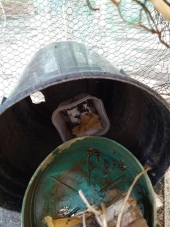




 I worried too much about the roots because I had forgotten to consider the positive effects that you pointed out to me.
I worried too much about the roots because I had forgotten to consider the positive effects that you pointed out to me.
 . I am not an expert in agriculture and before a year ago I had never read anything, even if a passion of mine was transmitted to me by my mother, who in turn inherited it from my grandfather.
. I am not an expert in agriculture and before a year ago I had never read anything, even if a passion of mine was transmitted to me by my mother, who in turn inherited it from my grandfather.

Joylynn Hardesty wrote:
Enzo Gorlomi wrote:
Considering that I will coppice/pollard them, I am more worried about roots and nutrients availability to main crops. In this sense, the question was about mulberry roots.
I think the roots are only spread as wide as the tree is tall. When coppiced, the roots will die back, to about how tall it has been coppiced to, adding a huglekulture effect to the area.
If you are doing a no-till garden, and nothing you have to dig out, like potatoes, I'm thinking the roots would be of no consequence. I have two mulberries, and the only factor I've had to adjust for is the shade. The trees are 5 and 7 years old. 20 to 30 feet tall, and scheduled for their first coppice this winter.
Oh, wait. The front tree is actually 3 in one planting. It was bird planted. I did coppice one of these two years back.
S Bengi wrote:Why not plant both, side by side. Maybe even months apart. Then if the mullberry and does well kill the willow.
Sebastian Köln wrote:Their canopy is certainly quite dense, depending on the variety even very dense.
So only shade tolerant plants will work. I can't speak about nutrients, but there are no nitrogen indicator plants growing around the mulberries here.
Tyler Ludens wrote:
Sebastian Köln wrote:Mulberry is great … if you manage to easily pick the ripe fruits.
Those here are more than 10m high with pretty much nothing in reach.
Mulberry can be maintained as a large shrub, producing lots of biomass when pruned. In my new garden I have one Willow and one Mulberry. So far the Mulberry is growing much faster in spite of having been drastically pruned twice by deer. So if I had to choose between the species, I would plant Mulberry instead of Willow. Mulberry is also more suited to my climate.